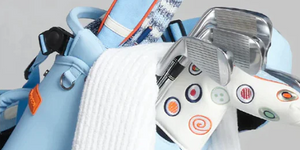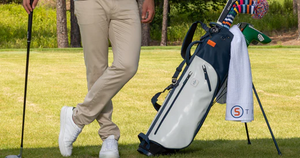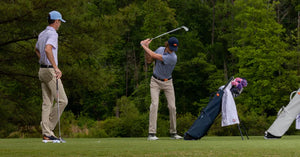High Spin VS Low Spin Golf Balls
Golf balls are usually classified as either “high-spin” or “low-spin.” This distinction is essential and can significantly impact your game; high and low spin balls behave differently. In this article, we'll list the pros and cons of each, so you can find the ball that works best for you and your game.
High Spin Golf Balls
This ball is usually considered high-end and especially great for precision golfers. Look for balls with 3 to 4 layers and a urethane finish for the most spin. If you're unsure what type of ball is best for you, check out all the pros and cons of high-spin balls below:
Pros
Higher Launch
As a golf ball flies, air travels across the dimples on the surface and creates spin. This movement and shape help the ball rise vertically in the air, similar to the way airplane wings work. With the proper aim, higher lifts can result in a farther traveling distance.
Descent Angle Control
The high launch angle means the ball will come down steeply, which many players prefer for their short game. This calculated control is ideal with clubs like a long iron, a hybrid, or a fairway wood.
Precise Stopping
The steeper descent angle also lends itself to faster and more precise stopping. These balls are more likely to backswing, which helps keep your ball on the green. It may even take a few strokes off your game!
Better Greenside Control
These balls are fantastic for veteran golfers who regularly hit chips, pitch, fade, or draw. They offer more control for advanced strokes but may take some experience to use correctly.
Cons
Loss of Distance
Because of the steep descent angle and backspin, these balls only roll a little after landing. Players with a higher handicap also tend to hit too high or fast, leading to shorter overall distances.
More Curvage
The dimpling that creates back and sidespin can also lead to curved shots. This dimpling can be an advantage for low-handicap players who know how to make the most of a curve shot, but it can be tricky for higher-handicap players.
More Likely to Slice or Hook
However, this type of ball is much more likely to slice or hook. If you're looking for a straight flight, opt for ionomer-covered balls.
Higher Price
The extra layers and urethane finish that give these balls their higher spin also drive up the price. These tend to be more expensive than low-spin balls, which is another reason they're better for more experienced players.
Does a High Spin Golf Ball Slice More?
Players at all levels are more likely to slice with a high-spin ball. The same forces that create the backspin ideal for controlled stops also create sidespin. Sidespin can happen in any direction and often leads to slices if the ball isn't hit with the proper force at the right angle. For a straight and more neutral flight, choose a ball with a lower spin.
Who Should Play a High Spin Golf Ball?
High spin balls are best for experienced, low-handicap players. These balls can be expensive and tricky to work with, so they're best left to players with the mastery and experience to use them properly.
Low Spin Golf Balls
Don't be fooled by the price tag - low spin balls have much to offer. They're great for players at all levels; even professional golfers use them in certain circumstances.
Pros
Straighter Shots
A low-spin ball rotates less as it travels through the air. This reduction in back and sidespin means the ball will fly straighter and can be more forgiving with hooks and slices.
Less Expensive
Low-spin balls tend to have only two or three layers, making them cheaper to produce. Indeed, this is another advantage - especially for high-to-middle handicap players who go through balls quickly.
Added Distance
One of the most significant advantages of low-spin balls is their greater horizontal travel distance. This feature is attractive to newbies and professionals alike. Since these balls experience less back and sidespin, most of the force behind the shot is carried forward in line with the impact. That means it will travel further and roll more once it lands.
More Durable
These balls tend to have an ionomer finish, which makes them harder and more substantial than urethane balls. This hardness increases durability, saving you a lot of money in the long run.
Cons
Lower Launch Angle
These balls often don't generate enough spin to get a good lift. The result is a long, straight shot. But that also means getting these balls over or around obstacles may be difficult.
Imprecise Stopping
Low to no backspin means imprecise stopping. These balls will travel further in the air and on the ground, often continuing to roll. Longer traveling distances can be a huge advantage, but it comes at the expense of precise stops.
Do Low Spin Golf Balls Go Farther?
Low-spin balls travel farther - both in the air and once they hit the ground and continue to roll. This distance is a plus for many players who want to come off the tee strong, but it can make your short game challenging.
Who Should Play a Low Spin Golf Ball?
In general, low-spin balls require less expertise than high-spin balls. This type of ball is an excellent all-around ball choice that works for players at every level. Think about it: professionals often use low-spin balls, but they're also great for beginners and everyone in between.



